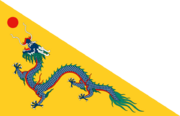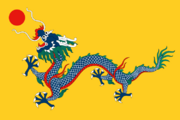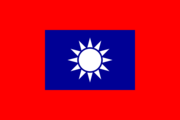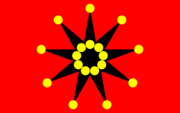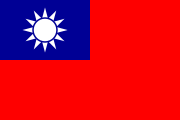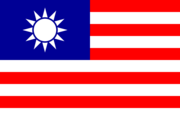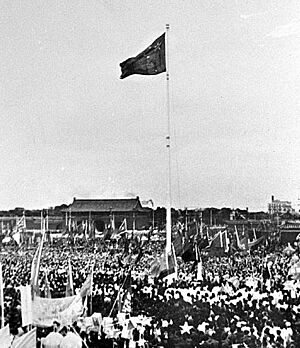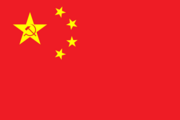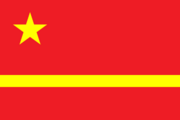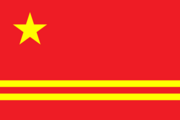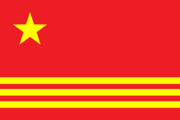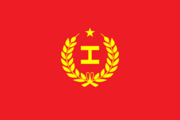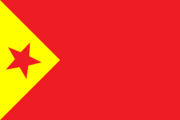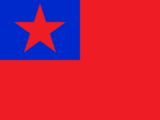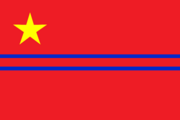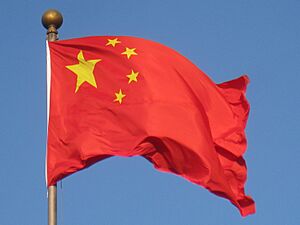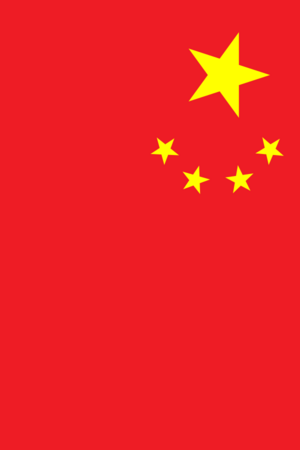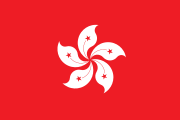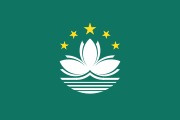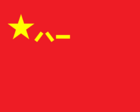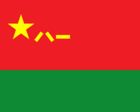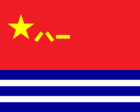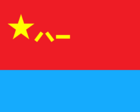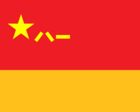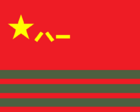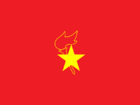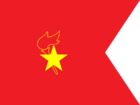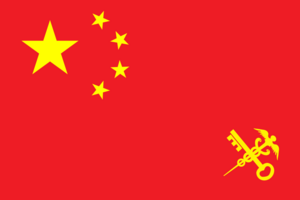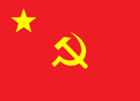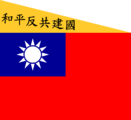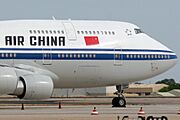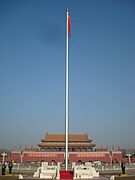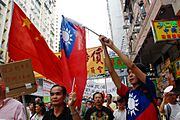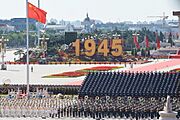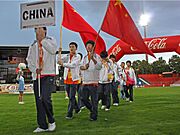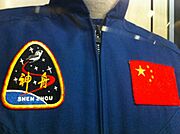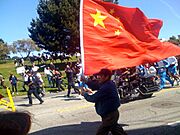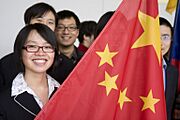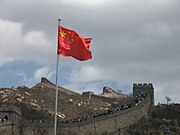Flag of China facts for kids
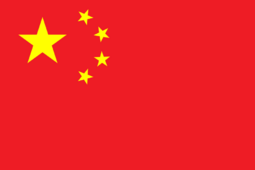 |
|
| Name | Five-star Red Flag |
|---|---|
| Use | Civil and state flag, civil and state ensign |
| Proportion | 2:3 |
| Adopted |
|
| Design | A large golden star within an arc of four smaller golden stars, in the canton, on a field of Chinese red. |
| Designed by | Zeng Liansong |
| Flag of China | |||||||||||||||
|---|---|---|---|---|---|---|---|---|---|---|---|---|---|---|---|
| Simplified Chinese | 中国国旗 | ||||||||||||||
| Traditional Chinese | 中國國旗 | ||||||||||||||
| Literal meaning | State flag of China | ||||||||||||||
|
|||||||||||||||
| Flag of the People's Republic of China | |||||||||||||||
| Simplified Chinese | 中华人民共和国国旗 | ||||||||||||||
| Traditional Chinese | 中華人民共和國國旗 | ||||||||||||||
| Literal meaning | State flag of the People's Republic of China | ||||||||||||||
|
|||||||||||||||
| Five-star Red Flag | |||||||||||||||
| Simplified Chinese | 五星红旗 | ||||||||||||||
| Traditional Chinese | 五星紅旗 | ||||||||||||||
|
|||||||||||||||
The national flag of the People's Republic of China, also called the Five-star Red Flag, is a bright red flag with five golden stars. One large star is in the upper left corner, and four smaller stars are placed in an arc around it. This flag has been China's national flag since October 1, 1949. That's when the People's Republic of China was founded. A person named Zeng Liansong designed the flag.
The red color on the flag stands for the Chinese Communist Revolution. The five stars show how different groups of Chinese people are united. The four smaller stars represent four social classes, while the large star stands for the Chinese Communist Party (CCP), which leads them. The flag was first raised in Beijing's Tiananmen Square on October 1, 1949. This happened during the ceremony that announced the new People's Republic of China.
Contents
China's Flag History
Early Chinese Flags
Before the current flag, China used the "Yellow Dragon Flag". This flag was used by the Qing dynasty, which was the last imperial family to rule China. They used it from 1862 until 1911, when the monarchy was overthrown. The first dragon flag was shaped like a triangle. Later, in 1889, they changed it to a rectangular version.
- Flags of the Qing dynasty
Flags of the Republic of China
The "Blue Sky with a White Sun" flag was an important design. It was created by Lu Haodong in 1895 for a revolutionary group. This design later became the flag for the Kuomintang political party. A red part was added to the flag in 1906 by Sun Yat-sen, making it look like the modern flag of the Republic of China.
When the Republic of China was formed in 1912, different revolutionary groups used various flags. One flag had 18 yellow stars. Another, called the "Five-Colored Flag," had five horizontal stripes. These stripes represented five main groups of people in China: Han (red), Manchu (yellow), Mongol (blue), Hui (white), and Tibetan (black).
The "Five-Colored Flag" became the national flag in 1912. However, Sun Yat-sen thought this flag wasn't quite right. He felt the horizontal stripes suggested a social ranking, like in old dynasties. Later, in 1928, the "Blue Sky with a White Sun and Wholly Red Earth" flag became the official national flag. This happened after the Northern Expedition overthrew the Beijing government.
During the Second Sino-Japanese War, Japan set up some puppet governments in China. One of these governments used the "Five-Colored Flag." Another government, led by Wang Jingwei, wanted to use the same flag as the main Chinese government to show its power. They eventually agreed to use the same flag, leading to two rival governments using the same symbol.
After the Chinese Civil War in 1949, the Republic of China government moved to Taiwan. On the mainland, Mao Zedong and his forces established the People's Republic of China and created their own new national flag.
- Flags of the Republic of China
-
 "Blue Sky with a White Sun" flag (Chinese: 青天白日旗). Kuomintang party flag and the ROC naval jack (1895–present)
"Blue Sky with a White Sun" flag (Chinese: 青天白日旗). Kuomintang party flag and the ROC naval jack (1895–present) -
 Flag of the Republic of China of the Nationalist government (flown only in Taiwan after 1949).
Flag of the Republic of China of the Nationalist government (flown only in Taiwan after 1949).
- Proposed designs of the Blue Sky, White Sun and Wholly Red Earth Flag
Creating the People's Republic of China Flag
In July 1949, a group called the Preparatory Committee asked people to submit designs for a new national flag. They wanted the flag to show Chinese culture and the new government's power. The flag needed to be rectangular and mostly bright red.
Zeng Liansong, a designer from Shanghai, wanted to create a flag that showed his love for the new country. He got his idea from looking at stars in the night sky. He thought of a Chinese saying, "longing for the stars, longing for the moon," which means hoping for something good. He saw the Communist Party as a "great saving star" for the Chinese people, which became the large star on the flag.
The four smaller stars came from a speech by Mao Zedong. Mao talked about four main groups of people in China: scholars, peasants, workers, and merchants. The yellow color of the stars suggests that China belongs to the Chinese people. Zeng sent his "Five Stars on a Field of Red" design to the committee in August.
Many designs were sent in, over 2,900! Zeng's design was not chosen at first. But then, a person named Tian Han suggested it again. On September 23, 1949, the leaders discussed the flags. Some people didn't like the idea of the four small stars representing different social classes. Mao Zedong liked a different design at first, which had a golden bar on a red flag. But others thought this looked like China was divided.
Later, Mao convinced everyone to choose Zeng's design, but with a small change. An earlier idea to include a hammer and sickle (like on the Soviet Union's flag) was removed. On September 27, 1949, Zeng's updated design was chosen. They named it the "Five-star Red Flag."
The new flag was shown to the public on September 29. It was officially raised for the first time by Mao Zedong in Tiananmen Square on October 1, 1949. This was the day the People's Republic of China was officially announced. Zeng Liansong was surprised his design was chosen. He was officially recognized as the flag's designer and received a reward for his work.
- Rejected designs of the Five-star Red Flag
-
 The "Yellow River" flag design originally preferred by Mao Zedong.
The "Yellow River" flag design originally preferred by Mao Zedong.
- Other rejected proposed designs
-
 Proposal by Zhu De
Proposal by Zhu De -
 Proposal by Liang Congjie
Proposal by Liang Congjie -
 Proposal by Guo Moruo
Proposal by Guo Moruo -
 Proposal by Guo Moruo
Proposal by Guo Moruo
What the Flag Means
The red background of the flag stands for the Chinese Communist Revolution. The five stars and how they are placed show the unity of the Chinese people. This unity is under the leadership of the Chinese Communist Party (CCP). The way the stars are angled shows that everyone should unite around a central point.
The large star represents the CCP. The four smaller stars around it stand for the four main social groups in China, as described by Mao Zedong. These groups are the working class, farmers, city dwellers with small businesses, and national business owners. Sometimes, people mistakenly think the five stars represent China's five largest ethnic groups. However, this idea comes from an older flag, the "Five Races Under One Union" flag, which used different colored stripes for different ethnic groups.
How the Flag is Made
There are specific rules for how the national flag should be made. These rules cover its size, shape, and colors. The government has published detailed instructions to make sure all flags are consistent.
For example, the flag is divided into a grid for its design. The large star is placed in a specific spot in the upper left. The four smaller stars are also placed at exact points and are rotated so their top points face the center of the large star.
There are different official sizes for the flag, depending on where it will be flown. For instance, flags flown on flagpoles have five standard sizes. There are also smaller sizes for other uses, like decorating cars or meeting rooms.
Flag Colors
The exact colors of the national flag are also very specific. They are defined using special color codes to ensure they are always the same. For example, the red and yellow colors have precise measurements for brightness and shade.
For computer displays, the official flag law points to standard image files. These files show the exact red and yellow colors to use in digital formats.
| Red | Yellow | |
|---|---|---|
| RGB | 238/28/37 |
255/255/0 |
| Hexadecimal | #EE1C25 |
#FFFF00 |
| CMYK | 0/88/84/7 |
0/0/100/0 |
Rules for the Flag
The National Flag Law of the People's Republic of China was put into effect on October 1, 1990. This law explains how to make, display, and respect the Chinese flag. It states that the flag is a very important symbol of China. Everyone should treat the flag with respect and care.
Where the Flag is Displayed
The law lists many places where the flag must be flown every day. These include Tiananmen Square, government buildings, and important entry points like airports and train stations. Other government offices and courts fly the flag on working days. Schools also fly the national flag every day, except during holidays and on Sundays.
Flag Order in Parades
When the national flag is carried in a parade with other flags, it must always be in front. This shows its importance.
Folding the Flag
There's a specific way to fold the flag:
- Fold it in half horizontally.
- Fold it in half horizontally again.
- Fold it in half vertically.
- Fold it in half vertically again.
- Fold it in half vertically one more time.
- Fold it vertically along the top edge.
Respecting the Flag
It is against the law to disrespect the flag in China. This means you should not damage or treat the flag poorly. Breaking this rule can lead to serious consequences.
Flags of Special Regions
China has two special regions called Special Administrative Regions: Hong Kong and Macau. These regions have their own unique flags. The rules for using these flags are set by China's National People's Congress.
The Flag of Hong Kong has a white, five-petal Bauhinia blakeana flower on a red background. Each petal has a small red star. This flag shows that Hong Kong is part of China. It also represents the "One country, two systems" idea, which means Hong Kong has its own special way of governing. This flag was adopted in 1990 and first raised officially in 1997, when Hong Kong was returned to China from the United Kingdom.
The flag of Macau is green. It features a white lotus flower, a bridge, and water. Above these are five golden stars in an arc. One star is larger and in the center, with four smaller ones around it. The lotus is Macau's special flower. The bridge is a famous landmark. The water shows Macau's history as a port city. The five stars are like those on China's national flag, showing Macau's connection to its home country. This flag was chosen in 1993 and first raised officially in 1999, when Macau was returned to China from Portugal.
Military Flags
The People's Liberation Army (PLA), which is China's military, uses six different flags. Most of these flags are red with a golden star and two Chinese characters, "八一" (Bā Yī), in the upper left corner. These characters mean "August 1st." They honor the day in 1927 when the PLA was formed to fight against the Kuomintang government.
The main PLA flag was created in 1949. Each part of the PLA, like the Ground Forces, Navy, Air Force, and Rocket Force, has its own flag. These flags are similar to the main PLA flag, but they have a colored bar at the bottom.
- The Ground Forces flag has a forest green bar, representing the land.
- The Navy flag has blue and white stripes, representing the sea.
- The Air Force flag has a sky blue bar, representing the air.
- The Rocket Force flag has a yellow bar, representing the flare of a missile launch.
In 2018, the People's Armed Police also received a new flag with three olive stripes at the bottom.
- Military flags
Chinese Communist Party Flags
The Chinese Communist Party (CCP) has its own flag. It was created on April 28, 1942. The flag is red and has the CCP's golden emblem in the upper left corner. The emblem shows a crossed hammer and sickle. This design was officially defined in the CCP Constitution in 1996.
The Communist Youth League of China also has a flag, adopted in 1950. It is a red flag with a golden star inside a golden ring in the middle.
The Young Pioneers of China use two flags. One is for larger groups (battalions) and has a golden Young Pioneers badge in the center. A smaller, modified flag is used for smaller groups (companies). This flag has a triangle cut out of its right edge, and the golden emblem is moved closer to the left.
- Organizational flags
Customs Flag
China's customs flag is the national flag with a special emblem in the lower right corner. This emblem has a golden key and a Caduceus (a staff with two snakes and wings) crossing each other. This flag was adopted in 1953. It is usually flown at the front of customs ships.
Historical Flags
- Historical flags
-
 Flag of the Qing dynasty (1889–1912)
Flag of the Qing dynasty (1889–1912) -
 Flag of the Republic of China (1912–1928), representing the Five Races Under One Union principle
Flag of the Republic of China (1912–1928), representing the Five Races Under One Union principle -
Flag of the Republic of China (1928–present)
-
Flag of the Kuomintang and the naval jack of the Republic of China Navy (1947–present)
-
 The flag of the Reorganized National Government of the Republic of China, a Japanese puppet state during World War II, was based on the Flag of the Republic of China.
The flag of the Reorganized National Government of the Republic of China, a Japanese puppet state during World War II, was based on the Flag of the Republic of China. -
 Russian flag used in Dalian (1895–1905)
Russian flag used in Dalian (1895–1905) -
 Soviet flag used in Dalian, Chinese Eastern Railway and its occupation of Manchuria (1945–1946)
Soviet flag used in Dalian, Chinese Eastern Railway and its occupation of Manchuria (1945–1946) -
 Imperial Japanese flag used in Kwantung Leased Territory (1905–1945), Taiwan (1895–1945) and occupied parts of southeastern China (1937–1945)
Imperial Japanese flag used in Kwantung Leased Territory (1905–1945), Taiwan (1895–1945) and occupied parts of southeastern China (1937–1945)
Gallery
- Flags in use
-
The PRC flag on an Air China Boeing 747-400.
-
Yao Ming holding the PRC flag during the 2008 Summer Olympics Parade of Nations.
-
PRC flag flying in the middle of Tiananmen Square.
-
Protesters waving PRC and ROC flags during an anti-Japan demonstration in Hong Kong in 2012.
-
PRC embassy in Nuku'alofa, Tonga with its national flag.
-
The PRC flag on the uniform of Shenzhou 5 spaceflight mission.
-
A man in San Francisco holding the PRC flag during the torch relay for the 2008 Summer Olympics.
-
Парад в честь 70-летия Великой Побебы - 40.jpg
The People's Liberation Army with the PRC flag during the 2015 Moscow Victory Day Parade.
-
Chinese students with the PRC flag at École Polytechnique.
-
The flag of the PRC flown on the Great Wall of China.
See also
 In Spanish: Bandera de la República Popular China para niños
In Spanish: Bandera de la República Popular China para niños
- List of Chinese flags
- Emblem of the People's Republic of China
- March of the Volunteers
- Flag of the Republic of China
- Red flag


